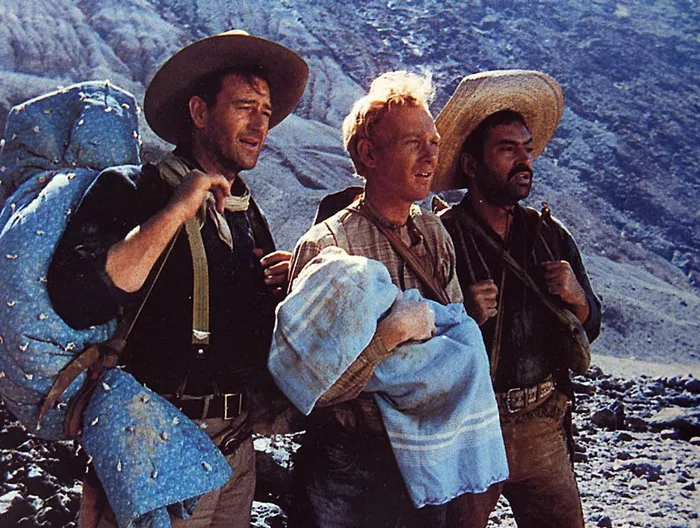The depiction of desert survival tactics in the 1948 John Wayne Western film ‘3 Godfathers’ has captured the attention of enthusiasts and experts alike. While the portrayal of survival techniques, particularly the use of the barrel cactus, appears to be fairly accurate, it is essential to approach the film’s depiction of survival with a degree of skepticism. Amidst the captivating storyline and stunning desert scenery, the film presents a blend of fiction and reality, prompting an exploration into the intricacies of its portrayal of survival in the harsh desert landscape.
I. The Accuracy of Desert Survival Tactics in 3 Godfathers
A. Spotlight on the Barrel Cactus Trick
The scene from ‘3 Godfathers’ showcasing the use of the barrel cactus as a source of water during desert survival is notably accurate, reflecting a degree of authenticity in its depiction of survival techniques. The film’s portrayal of this specific tactic underscores the resourcefulness and ingenuity that can be employed in dire circumstances, shedding light on the critical role of natural elements in sustaining life in the unforgiving desert terrain.
B. Balancing Fiction with Realism
While the film’s depiction of survival tactics demonstrates a degree of accuracy, it is imperative to approach the narrative with a balanced perspective that acknowledges the inherent blend of fiction and realism. The portrayal of survival in ‘3 Godfathers’ is embedded within the context of a fictional narrative, emphasizing the need to view the film’s depiction of survival through a lens that appreciates the creative liberties inherent in cinematic storytelling.
II. Expert Insights on the Portrayal of Survival in 3 Godfathers
A. The Importance of Context in Cinematic Portrayals
Expert analyses of ‘3 Godfathers’ underscore the significance of contextualizing the film’s portrayal of survival within the broader framework of cinematic storytelling. While the accuracy of certain survival tactics is acknowledged, the film’s narrative context and characterization of the main protagonists as non-experts in survival necessitate a nuanced understanding that accounts for the inherent dramatization and creative embellishments characteristic of the Western genre.
B. Recognizing the Nuances of Fiction and Reality
Experts emphasize the need to approach the depiction of survival in ‘3 Godfathers’ with a critical eye that recognizes the nuances of fiction and reality within the cinematic narrative. While the film offers insights into certain survival techniques, it also underscores the necessity of exercising caution in interpreting its portrayal of desert survival, particularly in light of the overarching narrative’s emphasis on religious symbolism, character development, and thematic exploration characteristic of John Ford’s directorial style.
III. The Entertaining Fiction of 3 Godfathers: Religious Symbolism and Scenic Grandeur
A. Religious Symbolism and Narrative Depth
Within the realm of its fictional narrative, ‘3 Godfathers’ interweaves elements of religious symbolism, offering a thematic depth that resonates with audiences. The film’s exploration of themes related to redemption, sacrifice, and the triumph of the human spirit against adversity reflects the timeless appeal of Western storytelling, underscoring the enduring legacy of John Ford’s directorial prowess in infusing cinematic narratives with profound thematic resonance.
B. Stunning Desert Scenery and Cinematic Grandeur
Beyond its narrative and thematic dimensions, ‘3 Godfathers’ captivates audiences with its stunning depiction of the desert landscape, epitomizing John Ford’s masterful command over cinematic grandeur. The film’s sweeping vistas and evocative portrayal of the harsh desert terrain serve as a visual testament to Ford’s directorial vision, showcasing the inherent allure and cinematic power of the Western genre’s ability to transport audiences into a world brimming with visual splendor and thematic richness.
Conclusion
The exploration of survival tactics and expert insights within the context of ‘3 Godfathers’ serves as a testament to the intricate interplay between fiction and reality within the realm of cinematic storytelling. While the film’s depiction of desert survival, particularly the utilization of the barrel cactus, offers a glimpse into the resourcefulness and ingenuity inherent in dire circumstances, it is imperative to approach the narrative with an understanding of its inherent blend of fiction and realism. As the legacy of John Wayne’s 3 Godfathers endures, it continues to captivate audiences with its blend of religious symbolism, thematic depth, and stunning cinematic grandeur, embodying the timeless allure and enduring resonance of the Western genre’s captivating narrative tapestry.

